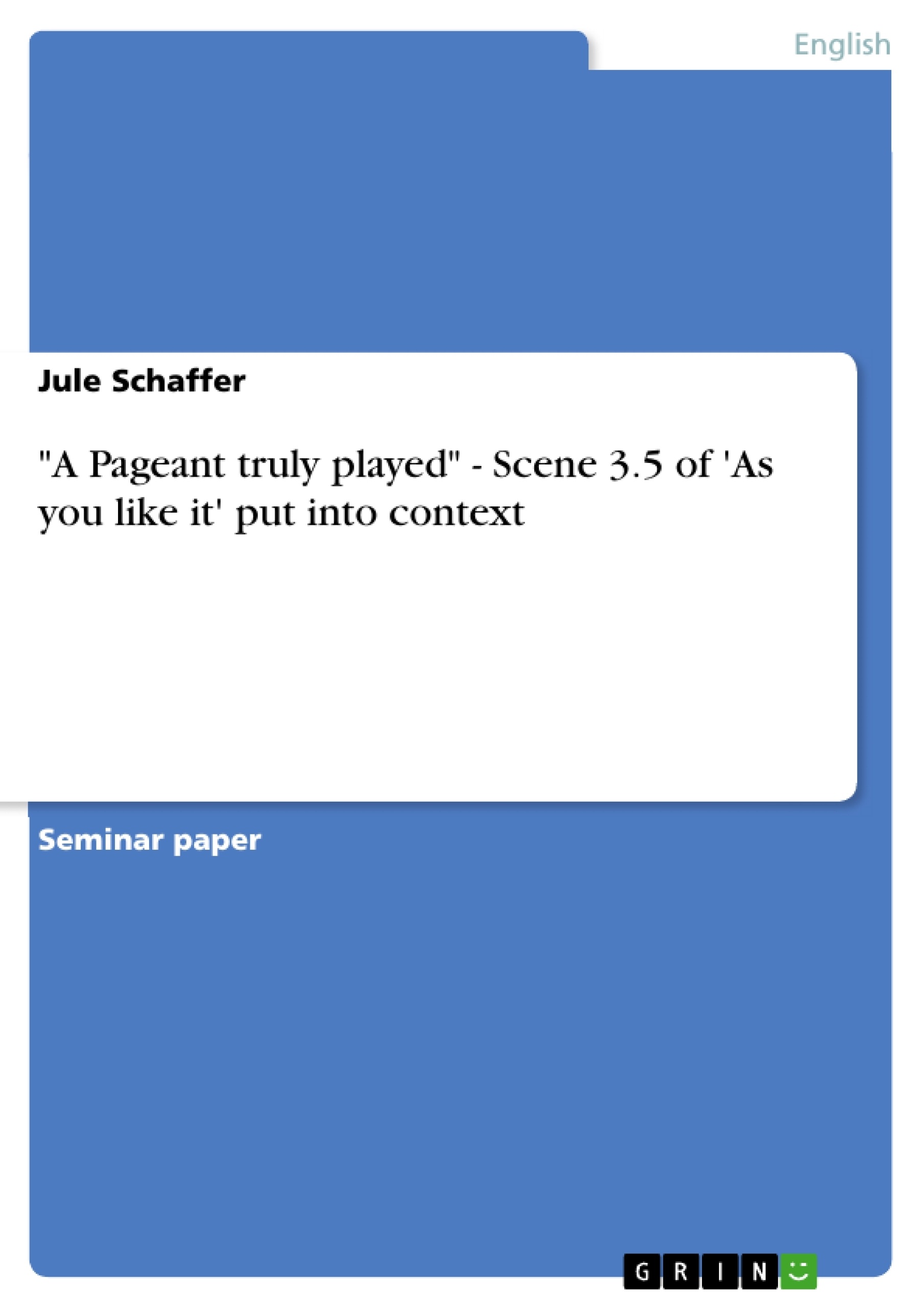There is much literature about Shakespeare today, exploring many facettes of "As you like it" and discovering many more all the time. This paper focuses on the main points I think relevant for the particular scene 3.5., put in the context of the play.
[…] A pageant truly played
between the pale complexion of true love
And the red glow of scorn and proud disdain […] (As you like it: 3.4.47-49)
As such describes Corin the following scene 3.5., in which a madly in love Silvius hopelessly woos his beloved Phoebe, a ”proud disdainful shepherdess,” (3.4.45). The scene is a play within a play and Rosalind herself decides to “prove a busy actor” (3.4.55) in this play. The scene is central to As you like it and seems to incorporate many of the images and ideas generally portrayed throughout the play.
To start off, the paper gives a broad overview of critical reception and performance history. Both of these points will be illustrated by focusing on a few examples of the main critical voices and performances. Next, we will specifically look at scene 3.5., critically analysing it under the heading of the following ideas.
One of the main themes underlying this sequence is the use and mocking of literary pastoral, along with various representations of love and mimetic desire. Phoebe’s sudden eruption of feeling for Rosalind/ Ganymede also leads to the necessary consideration of the heroine’s disguise and its roots and effects on the different levels of acting.
In a last step then, the paper brings this theoretical analysis to a more practical level and looks at ways in which the ideas worked out in chapter 4. could be visualised on stage.
Inhaltsverzeichnis (Table of Contents)
- Introduction
- Critical Reception
- Performance History
- Close critical Analysis of scene 3.5.
- The Pastoral
- Mimetic desire and transformation.
- Gendered desire.
- Performance as Interpretation: two contrasting production ideas
- Classroom production: Comparing the concepts of pastoral and talk-show
- The abyss of mimetic desire
- Conclusion
Zielsetzung und Themenschwerpunkte (Objectives and Key Themes)
This paper examines the significance of scene 3.5. in Shakespeare's "As You Like It," exploring the interplay of various thematic elements within the context of the play. The paper aims to provide a comprehensive analysis of this pivotal scene by focusing on its critical reception, performance history, and theoretical framework.
- The use and mocking of literary pastoral.
- Representations of love and mimetic desire.
- The impact of Rosalind's disguise and its effect on the different levels of acting.
- The interplay of gender and sexuality in the scene.
- The potential for theatrical production to interpret and visualize these ideas.
Zusammenfassung der Kapitel (Chapter Summaries)
The paper begins by examining the critical reception of "As You Like It," specifically focusing on interpretations of Shakespeare's treatment of pastoral conventions in the play. Critics offer diverse perspectives on whether Shakespeare mocks or embraces the pastoral, with notable examples from Alan Brissenden and David Young highlighting the debate.
The analysis then explores the performance history of "As You Like It," highlighting how different eras have interpreted Rosalind's character and the evolution of staging practices. The discussion considers the influence of gender representation and the significance of Rosalind's male disguise in the context of Renaissance social norms.
The paper then delves into a close critical analysis of scene 3.5., examining the interplay of various thematic elements, including pastoral conventions, mimetic desire, and the complexities of gendered desire. It explores how these themes contribute to the scene's significance within the overall narrative.
Schlüsselwörter (Keywords)
Shakespeare, As You Like It, pastoral, mimetic desire, gender, performance, Rosalind, disguise, theatrical production, critical reception, performance history.
- Citar trabajo
- Jule Schaffer (Autor), 2006, "A Pageant truly played" - Scene 3.5 of 'As you like it' put into context, Múnich, GRIN Verlag, https://www.grin.com/document/73784



